
archives for 05/2019
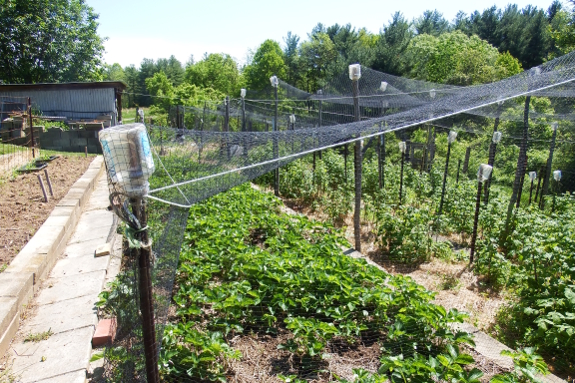
I wrangled a tour of a 56-year-old garden this week --- such a treat!
Shown here is bird netting atop the berry patch, which easily slides
into place each season due to applesauce jugs on top of the posts.
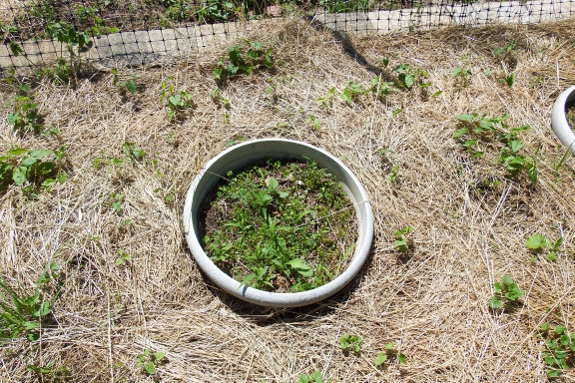
Voles are a major issue in this good soil, which makes growing sweet
potatoes a struggle. This gardener's solution? She drills lots of small
holes in the bottom of big pots, sinks them in the ground, fills them
with compost, then adds the sets.
Voles can't get in through the bottom or sides and the raised lip
prevents them from running straight in the top. The result is tubers
without nibbles --- a relief.
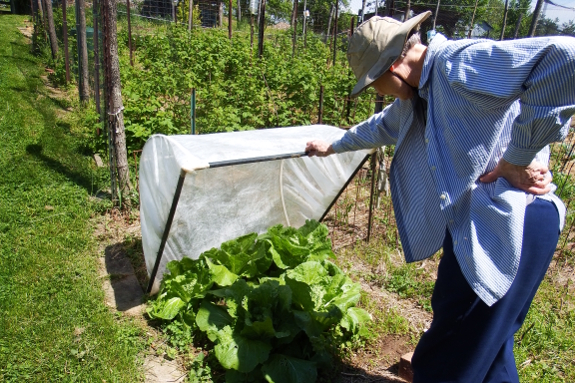
My tour guide also developed her own version of quick hoops, these even
quicker than mine since they're one structural piece and can be simply
lifted off and set aside. For ultra-early tomatoes, she sets out a
couple of plants under her covers and mitigates the temperature further
with full jugs of water.
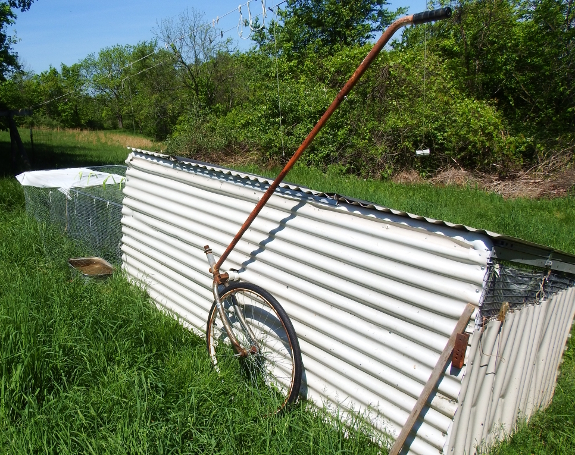
The next innovation is on the chicken side of the property. A welder
handy man made this two-part tractor easy to move with the addition of
modified bicycle wheels.
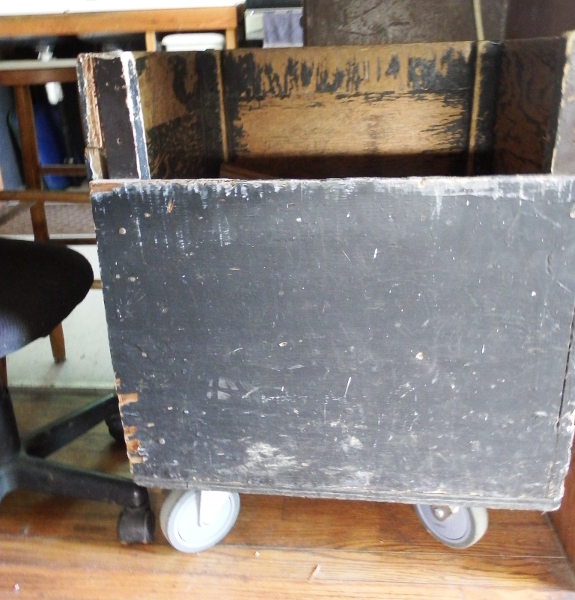
Meanwhile, a rolling wood bin keeps interior heating easy for older
arms and backs.
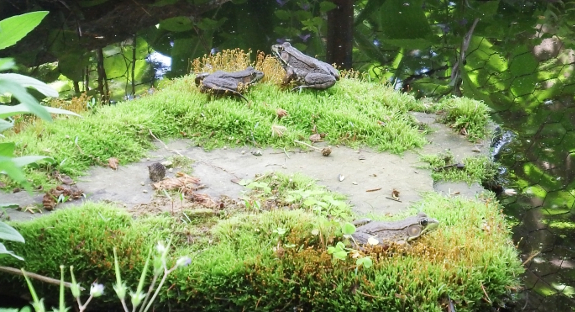
"So what was your favorite part? Did any of it give you garden envy?"
Mark asked when I got home.
The truth is, the only part of the tour that made me jealous was the
darling water garden beside her screened-in summer kitchen. Now that my
vegetable patch is smaller, maybe I have time for a little
extracurricular gardening?
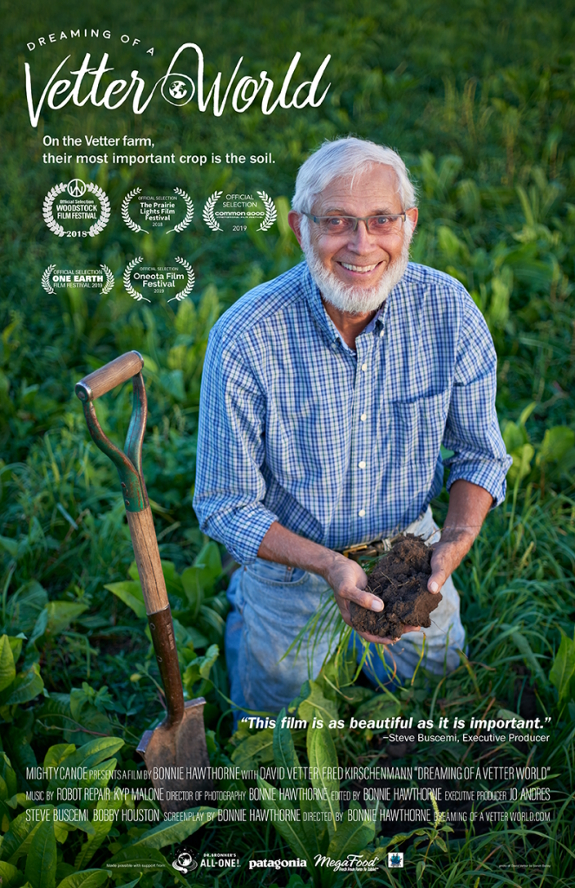
Mark and I recently attended a showing of Dreaming
of a Vetter World, with a
Q&A by Donald Vetter afterwards. If you've never heard of him,
Vetter
is a farmer right up Joel
Salatin's alley who uses long crop rotations combined with
rotational grazing to improve his soil. After decades of this
treatment, Vetter's
soil can soak in up to eight inches of rain per hour while his
neighbors' conventional fields start ponding and eroding after half an
inch in a similar time period.
So what does Vetter do to get such great results? He uses a nine-year
rotation, a third of which involves cows and pigs on pasture. We'll
start with that part --- the soil-building end of the spectrum. After
planting a grass/legume/forb mixture, he utilizes rotational grazing
for
three years, then he tills the rich greenery in.
Next comes the cash crops --- soybeans in year one, corn in year two,
then an Ethiopian land race of barley that his sister company (a
small-scale, organic grain-processing operation) bags up to sell as
bird seed. After a winter of cover
cropping combined with fall and
winter grazing, it's back to soybeans for a year followed by a final
season of popcorn.
Using this rotation, Vetter has added no off-farm inputs for twenty
years and sees annual improvement of his soil. He doesn't even buy
animal feed --- the waste seeds from his
grainary supplement his livestock's dependency on grass. The result is
a beautiful permaculture system that runs smoothly...when combined with
a lot of hard work.
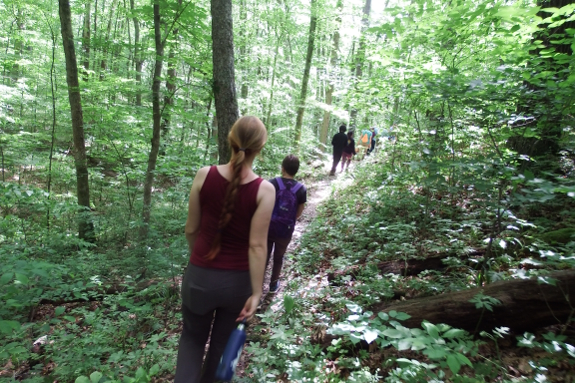
The second Rural
Action mushroom foray took to the woods amid pollen so severe my
black shirt turned gray and my eyes began couldn't quite decide whether
to itch or tear up. I don't even get allergies! I can't imagine how the
more susceptible felt.
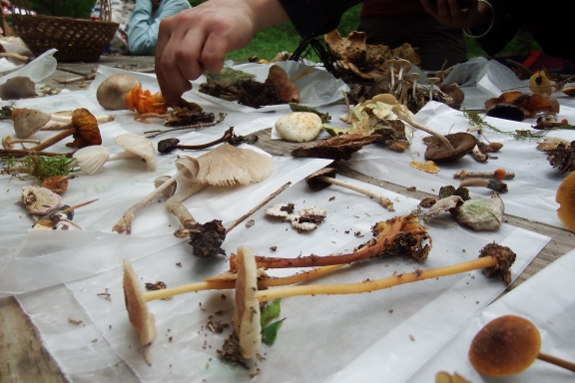
Despite adverse
conditions, we collected over twenty species in three short hours.
While plucking fungi from the woods, many seemed very similar and I had
a sinking suspicion I was bagging the same species over and over. But
once we spread them out on the picnic table, differences became clear.
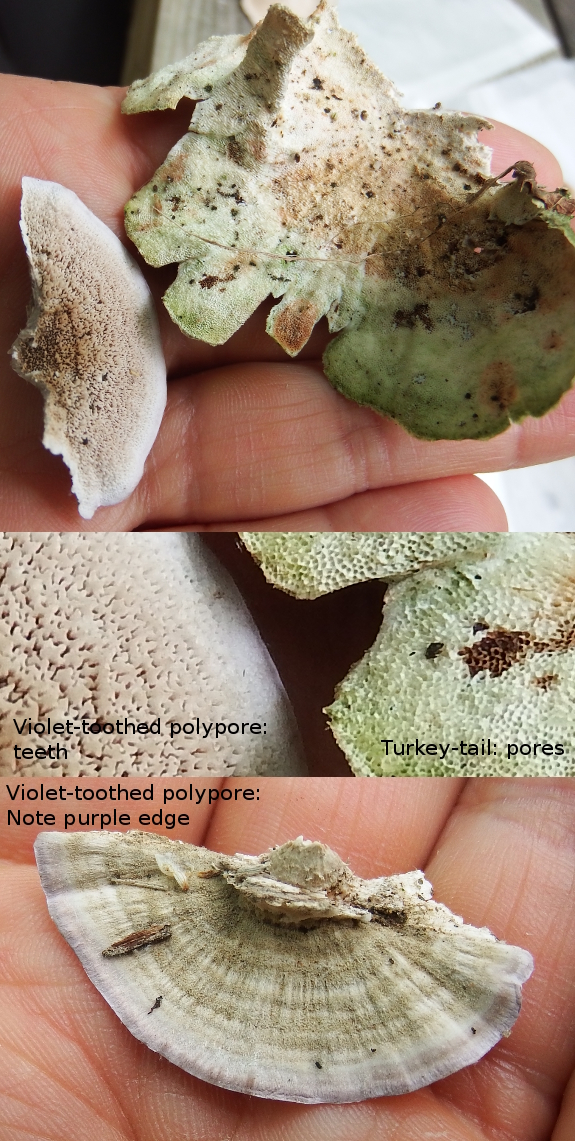
I'm going to focus on
the edibles again (although I've included a couple of inedible beauties
at the end of this post). First, another turkey-tail lookalike ---
violet-toothed polypore. My specimens of both species are old and
faded, but you can still see a little purple around the rim of the
polypore, the same color that is much more obvious underneath when the
fungi are fresh.
Lacking that giveaway,
you can distinguish violet-toothed polypores from turkey-tails by
peering at the undersides with a hand lens. As the name suggests, the
former has teeth while the latter boasts pores.
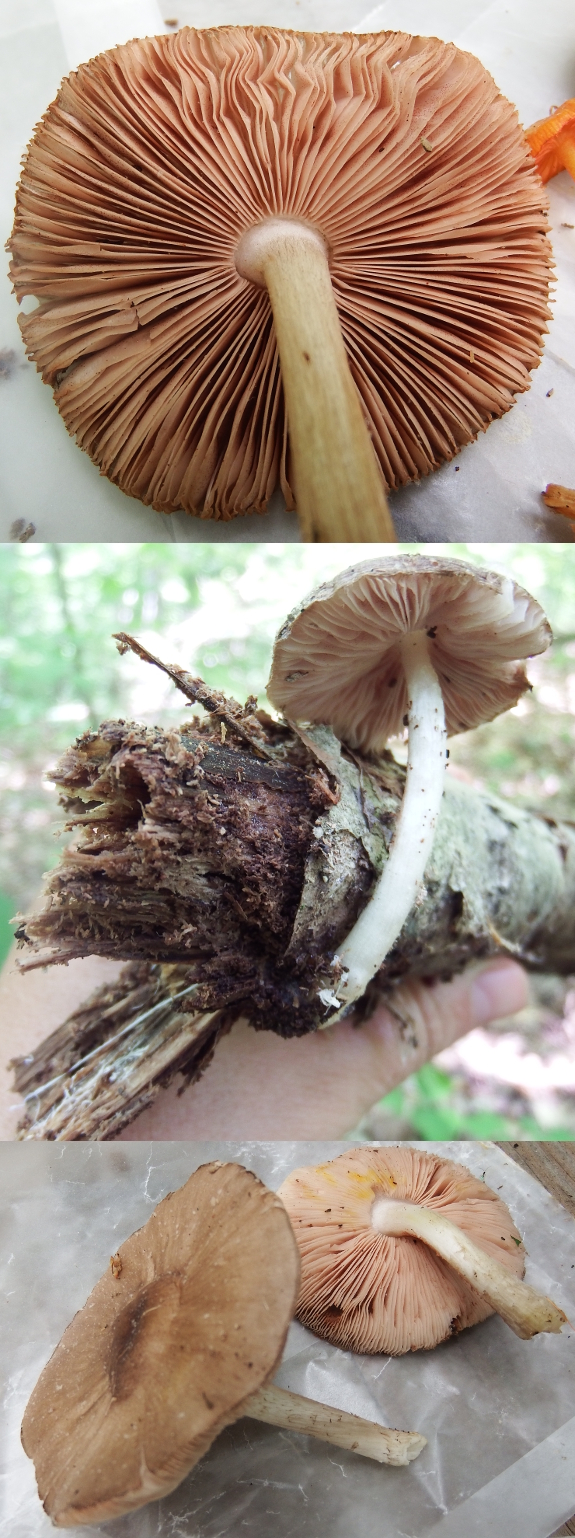
Next, a new-to-me
edible...that I never would have been brave enough to taste on my own.
Fawn mushroom (aka deer mushroom or Pluteus
cervinus) looks
an awful lot like another hundred or so species of brown, gilled
mushrooms. But if you peer closer, there are quite a few distinguishing
features.
First pay attention to
ecology --- fawn mushrooms grow on rotting wood. The gills are free, as
you can see in the top photo. And (at least when they get a little age
on them) the pink color underneath can be distinctive.
The real clincher,
though, is the aroma. Fawn mushrooms smell just like lightning bugs!
With that in mind, I was much more willing to cook them up to taste.
Flavor was good but not
amazing. Worth eating if you stumble across them, but not worth an
earmarked hunt.
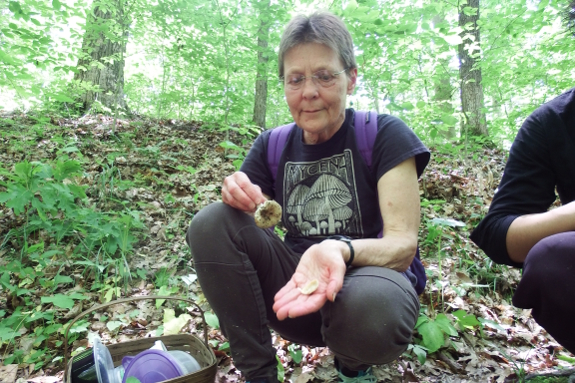
A huge thank you to our
fearless leader who helped us separate the wheat from the chaff.
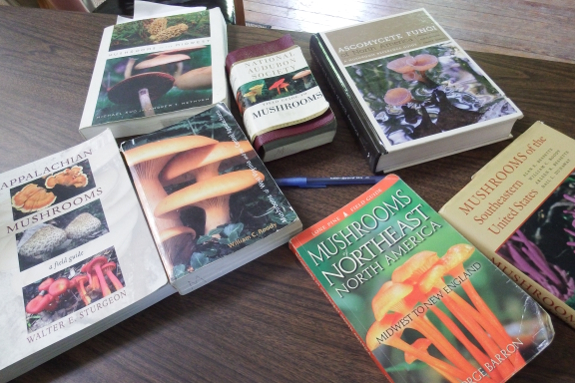
Although she didn't
appear to consult her library, Martha recommended the books above for
mushroom-hunting in southeast Ohio.
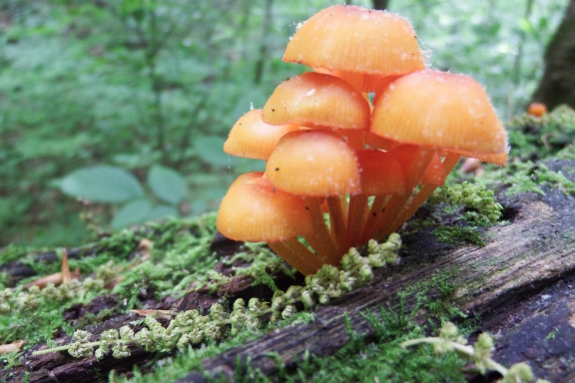
And now, eye candy!
Orange mycena...
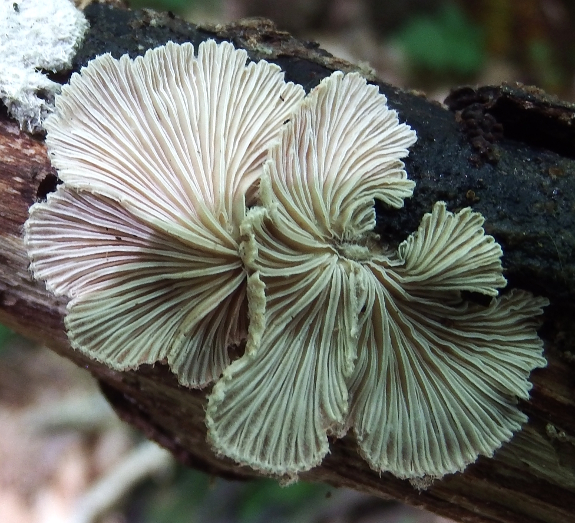
...and my very favorite,
the split-gill mushroom.
I wonder what we'll find
next month?
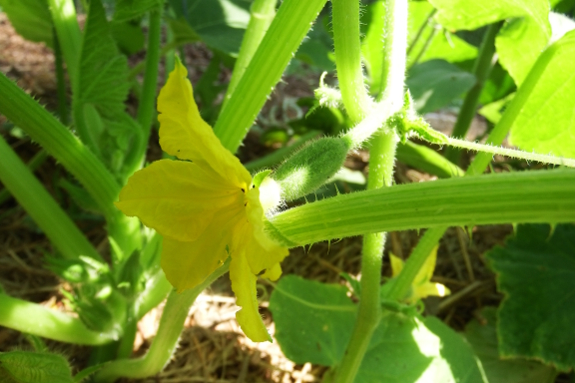
We ate as much as we safely could of our first-year asparagus, have
gorged on lettuce and broccoli and kale, and now it's time for the
summer crops to begin. An ultra-early last frost means ultra-early
cucumber blooms. We should be adding these crunchy fruits to our salads
starting next week.
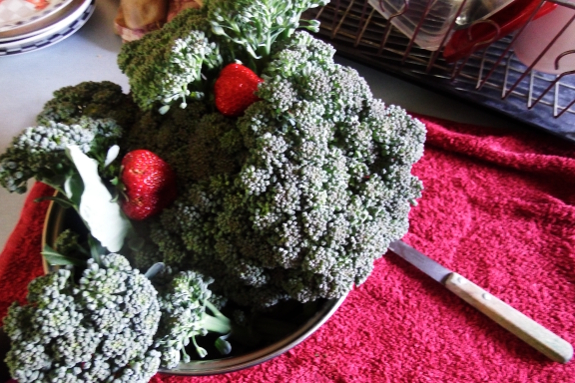
On a broccoli side note --- lowish nitrogen in the soil meant our heads
were smaller, but also faster, than usual. Interestingly, we've also
seen very few cabbageworms so far this spring. The moths have been
quite visible, but seem to prefer the flowering kale at the moment.
Could that be because of the lower-nitrogen plants?
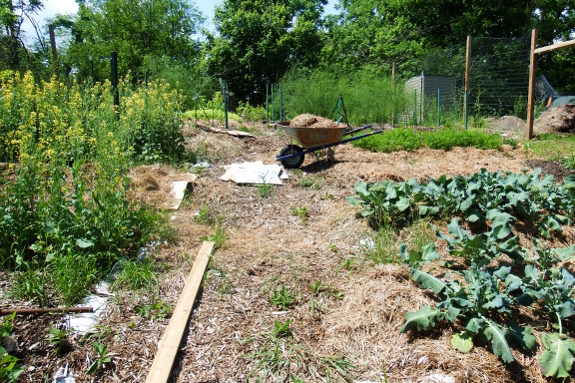
Lower cabbageworm pressure means I've been able to leave the broccoli
plants in place for side shoots to form. (I usually pull them out after
first spring heading because otherwise they become a bad-bug nursery.)
The result? Possibly more total pounds of harvest than previously,
definitely spread over a longer time span. Despite not planning to
preserve excess food this year, I ended up packing away about a gallon
of broccoli in the freezer.
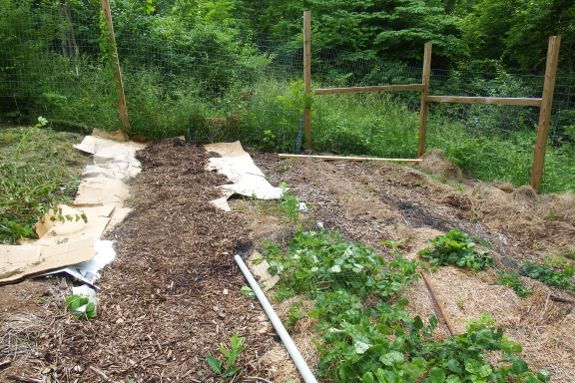
On a less pleasant note, our strawberry harvest looks like it will be
nonexistent. The berries started, a bird found them, I put bird netting
on top...and someone strong and vigorous (probably a squirrel) snuck
underneath and worked through the patch like a tornado. Every
strawberry of any size was removed, discards were strewn around the
garden, and Mark is now working on a berry enclosure to ensure this
won't happen again next year.
You win some and you lose some.
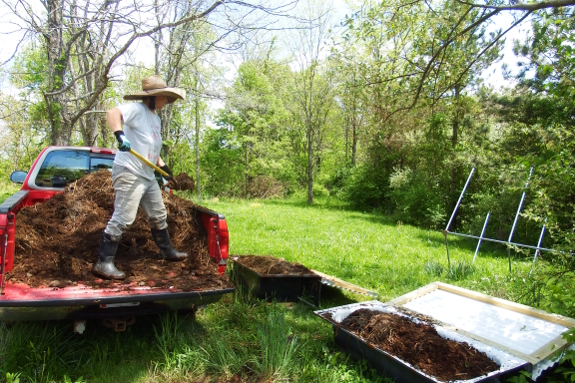
Speaking of winning --- wow, the manure! We're stocking up on
truckloads of this precious resource, in part because it disappeared
midsummer last year but also because the organic matter is full of wood
shavings and needs some rotting before it will be putting off much
nitrogen for our plants. Our worm bins quickly filled up, so now we're
starting a manure pile in the yard.
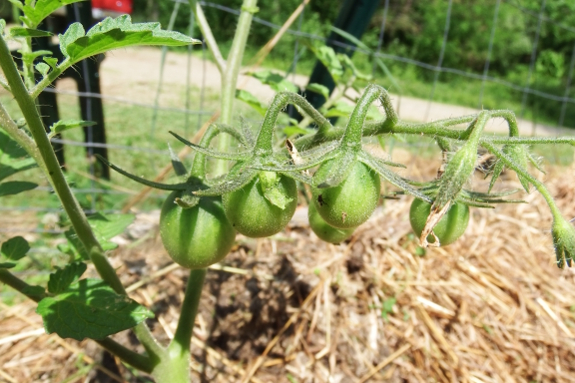
I'm also laying manure down on beds I don't plan to use in the next
several weeks, the time expanded from my initial plan of the next
month. Why? Because the tomatoes I set out into one-month-old manure
beds turned yellow and required chicken-manure topdressing to save
them. Luckily, they've now bounced back and are setting fruit.
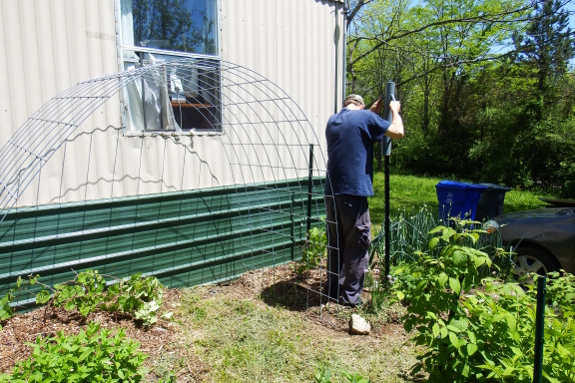
In our second year, we're also starting to have a bit of time for
prettiness, like this grape trellis Mark made out of a cattle panel and
four fence posts.
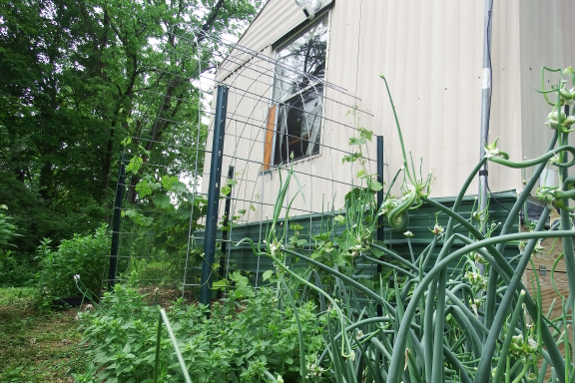
A few weeks after erecting it, the 18-month-old grape vines are already
starting to fill their space. One plant has even begun to bloom!
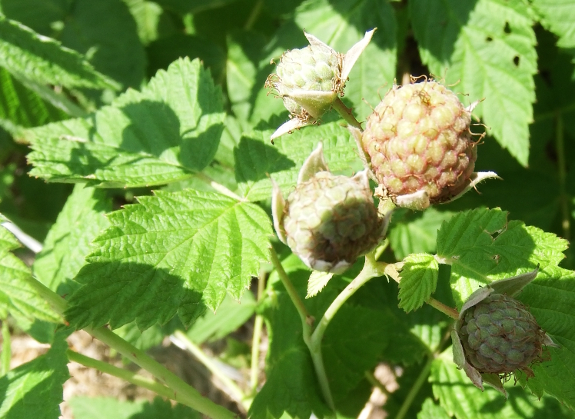
What's coming up? This is a Prelude raspberry, a new-to-us variety
that's supposed to ripen before any other brambles in the patch. It
didn't bloom any earlier than my other varieties, but fruits are
starting to plump and blush. If the birds don't get them, we might have
a replacement to my demolished strawberries!
Want more in-depth information? Browse through our books.
Or explore more posts by date or by subject.
About us: Anna Hess and Mark Hamilton spent over a decade living self-sufficiently in the mountains of Virginia before moving north to start over from scratch in the foothills of Ohio. They've experimented with permaculture, no-till gardening, trailersteading, home-based microbusinesses and much more, writing about their adventures in both blogs and books.
